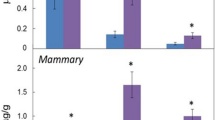Abstract
THE use of pharmacological agents to prevent development of epithelial cancer is attracting increasing attention. Recent studies have shown the successful use of vitamin A and its synthetic analogues (together known as retinoids) for this purpose1,2. We have shown that both natural and synthetic retinoids (retinyl acetate and retinyl methyl ether, respectively) markedly inhibit mammary carcinogenesis induced in the Sprague-Dawley rat by 7,12-dimethylbenz [a] anthracene (DMBA) (refs 3, 4). Although the DMBA model has contributed significantly to the understanding of mammary carcinogenesis, particularly hormone responsiveness, the model is less than ideal in that the tumours only rarely invade surrounding tissues and do not metastasise. A new mammary carcinogenesis model, first described by Gullino et al.5, using intravenous injection of N-methyl-N-nitrosourea (NMU) in the Buffalo rat, satisfies the deficiencies of the DMBA model in that cancers are exclusively localised in the mammary gland, are hormone dependent, show metastasis to other organs, are transplantable, and result in hypercalcaemia. NMU also causes a high incidence of mammary cancers in female Sprague–Dawley and Fischer-344 rats5, but the biological characteristics of the cancers in these strains have not been described in detail. But, our preliminary studies using Sprague–Dawley rats indicated that NMU-induced mammary cancers are highly aggresive and similar histologically to those induced in the Buffalo rat. The NMU model of mammary cancer thus resembles the human disease more closely than the DMBA model. We describe here a study of the effect of a retinyl acetate on mammary carcinogenesis induced by NMU, using a modification of the procedure reported by Gullino et al.5. We show that retinyl acetate inhibits carcinogenesis in this system.
This is a preview of subscription content, access via your institution
Access options
Subscribe to this journal
Receive 51 print issues and online access
$199.00 per year
only $3.90 per issue
Buy this article
- Purchase on Springer Link
- Instant access to full article PDF
Prices may be subject to local taxes which are calculated during checkout
Similar content being viewed by others
References
Sporn, M. B., Dunlop, N. M., Newton, D. L. & Smith, J. M. Fedn Proc. 35, 1332–1338 (1976).
Sporn, M. B. Nutr. Rev. 35, 65–69 (1977).
Moon, R. C., Grubbs, C. J. & Sporn, M. B. Cancer Res. 36, 2626–2630 (1976).
Grubbs, C. J., Moon, R. C., Sporn, M. B. & Newton, D. L. Cancer Res. 37, 599–602 (1977).
Gullino, P. M., Pettigrew, H. M. & Grantham, F. H. J. natn. Cancer Inst. 54, 401–414 (1975).
Doll, R. Nature 265, 589–596 (1977).
Druckrey, H., Preussmann, R., Ivankovic, S. & Schmähl, D. Z. Krebsforschung 69, 103–201 (1967).
Moore, T. in The Vitamins 2nd edn (eds Sebrell, W. H. & Harris, R. S.) 1, 280–294 (Academic, New York, 1967).
Lasnitzki, I. Br. J. Cancer 9, 434–441 (1955).
Chopra, D. P. & Wilkoff, L. J. J. Natn. Cancer Inst. 56, 583–589 (1976).
Smith, F. R. & Goodman, D. S. New Engl. J. Med. 294, 805–808 (1976).
Author information
Authors and Affiliations
Rights and permissions
About this article
Cite this article
MOON, R., GRUBBS, C., SPORN, M. et al. Retinyl acetate inhibits mammary carcinogenesis induced by N-methyl-N-nitrosourea. Nature 267, 620–621 (1977). https://doi.org/10.1038/267620a0
Received:
Accepted:
Issue Date:
DOI: https://doi.org/10.1038/267620a0
This article is cited by
-
Metabolomic alternations of follicular fluid of obese women undergoing in-vitro fertilization treatment
Scientific Reports (2020)
-
Biochemical properties of retinoid-converting enzymes and biotechnological production of retinoids
Applied Microbiology and Biotechnology (2015)
-
Nutrition and breast cancer
Cancer Causes and Control (1996)
-
Modification of benzo(a)pyrene induced chromosomal damage in mouse bone marrow by Vitamin A
Bulletin of Environmental Contamination and Toxicology (1990)
Comments
By submitting a comment you agree to abide by our Terms and Community Guidelines. If you find something abusive or that does not comply with our terms or guidelines please flag it as inappropriate.



